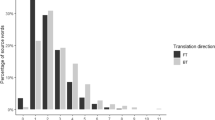Abstract
The process of lexical choice usually consists of determining a single way of expressing a given content. In some cases such as gerund translation, however, there is no single solution; a choice must be made among several variants which differ in their syntactic behavior. Based on a bilingual corpus analysis, this paper explains first which factors influence the availability of variants. In a second step, some criteria for deciding on one or the other variant are discussed. It will be shown that the stylistic evaluation of the syntactic structures induced by alternative lexical items is of central importance in lexical choice. Finally, an implementation of the resulting model is described.
Similar content being viewed by others
References
Alexander L. G.: 1988, Longman English Grammar. Longman, London.
Ballstaedt Steffen-Peter and Heinz Mandl: 1988, ‘The assessment of comprehensibility’, in Ulrich Ammon et al. (eds), Sociolinguistics, de Gruyter, Berlin, pp. 1039–1052.
Busemann Stephan: 1992, Generierung natürlicher Sprache mit Generalisierten Phrasenstruktur-Grammatiken. Springer, Berlin.
Chomsky Noam: 1970, Remarks on Nominalization, in Roderick A. Jacobs and Peter S. Rosenbaum (eds), Readings in English Transformational Grammar, Ginn, Waltham, MA, pp. 184–221.
Davison Alice and Georgia M. Green (eds): 1988, Linguistic Complexity and Text Comprehension: Readability Issues Reconsidered. Erlbaum, Hillsdale, NJ.
DiMarco Chrysanne and Keith Mah: 1994, ‘A model of comparative stylistics for machine translation’, Machine Translation 9, 27–59.
Duden Deutsches Universalwörterbuch. 1989, 2nd ed. Dudenverlag, Mannheim.
Emele Martin, Ulrich Heid, Stefan Momma, and Rémi Zajac: 1992, Interactions between linguistic constraints: Procedural vs. declarative approaches, Machine Translation 7, 61–98.
Ford Marilyn, Joan Bresnan, and Ronald Kaplan: 1982, ‘A Competence-based theory of syntactic closure’, in J. Bresnan (ed), The Mental Representation of Grammatical Relations, MIT Press, Cambridge, MA, pp. 727–796.
Friederich Wolf: 1973, Probleme der Semantik und Syntax des englischen Gerundiums, Max Hueber Verlag, München.
Gawronska, Barbara: 1993, An MT Oriented Model of Aspect and Article Semantics, Lund University Press.
Gorfein D.S. (ed): 1989, Resolving Semantic Ambiguity, Springer, Heidelberg.
Grimshaw Jane: 1990, Argument Structure, MIT Press, Cambridge, MA.
Grimshaw Jane and Edwin Williams: 1993, ‘Nominalization and predicative prepositional phrases’, in J. Pustejosky (ed), Semantics and the Lexicon, Kluwer, Boston/Dordrecht, pp. 97–106.
Groeben Norbert: 1978, Die Verständlichkeit von Unterrichtstexten. Aschendorff, Münster.
Horacek, Helmut: ‘Lexical choice in expressing metonymic relations in multiple languages’, Machine Translation 11, this issue.
Hovy Eduard H.: 1988, Generating Natural Language under Pragmatic Constraints. Lawrence Erlbaum, Hillsdale, NJ.
Hutchins W. John and Harold Somers: 1992, An Introduction to Machine Translation. Academic Press, London.
Iordanskaja Lidija, Richard Kittredge, and Alain Polguère: 1991, ‘Lexical selection and paraphrase in a meaning-text generation model’, in Cécile Paris, William R. Swartout, and William C. Mann (eds), Natural Language Generation in Artificial Intelligence and Computational Linguistics, Kluwer, Dordrecht, pp. 293–312.
Kilby David: 1984, Descriptive Syntax and the English Verb, Croom Helm, London.
Knight, Kevin and Ishwar Chander: 1994, Automatic Postediting of Documents, in Proceedings of AAAI '94 July 31–August 4, Seattle, Washington, pp. 779–784.
Koptjevskaja-Tamm Maria: 1993, Nominalizations, Routledge, London.
Laurian Anne-Marie: 1986, ‘Stylistics and computing: Machine translation as a tool for a new approach to stylistics’, Computers and Translation 1, 215–223.
Lyons, John: 1977, Semantics. Vols. 1, 2, Cambridge University Press.
Lyons John: 1980, Semantik. Band 1, Beck, München.
Lyons John: 1983, Semantik. Band 2, Beck, München.
Mehl Stephan: 1993, Dynamische semantische Netze. Zur Kontextabhängigkeit von Wortbedeutungen, Infix, St. Augustin.
Mehl, Stephan: 1995, ‘Interaction between syntax and semantics: The case of gerund translation’, in K. de Smedt (ed), Proceedings of 5th European Workshop on Natural Language Generation, Leiden, pp. 33–42.
Meteer Marie: 1992, Expressibility and the Problem of Efficient Text Planning, Pinter, London.
Nirenburg Sergei: 1992, ‘Text planning with opportunistic control’, Machine Translation 7, 99–124.
Nogier Jean-Francois and Michael Zock: 1992, ‘Lexical choice as pattern matching, in T. Nagle, J. Nagle, L. Gerholz, and P. Eklund (eds.), Conceptual Structures, Ellis Horwood, New York, pp. 413–435.
Pustejovsky James: 1991, ‘The generative lexicon’, Computational Linguistics 17, 409–441.
Pustejovsky James: 1991, ‘The syntax of event structure’, Cognition 41, 47–81.
Pustejovsky James: 1993, ‘Type coercion and lexical selection’, in J. Pustejovsky (ed), Semantics and the Lexicon, Kluwer, Boston/Dordrecht, pp. 73–94.
Pustejovsky James (ed): 1993, Semantics and the Lexicon, Kluwer, Boston/Dordrecht.
Quirk Randolph, Sidney Greenbaum, Geoffrey Leech, and Jan Svartvik: 1972, A Grammar of Contemporary English, Longman, London.
Raith Werner: 1988, Gut schreiben. Ein Leitfaden, Campus, New York.
Roeper Tom: 1993, ‘Explicit syntax in the lexicon: The representation of nominalizations’, in Pustejovsky J. (ed) Semantics and the Lexicon, Kluwer, Boston/Dordrecht, pp. 185–220.
Schippan Thea: 1967, Die Verbalsubstantive der deutschen Sprache der Gegenwart, Habilitationsschrift, Leipzig.
Somers Harold, Hideki Hirakawa, Seiji Miike, and Shinya Amano: 1988, ‘The treatment of complex English nominalizations in machine translation’, Computers and Translation 3, 3–21.
Stede Manfred: 1995, ‘Lexicalization in natural language generation: A survey’, Artificial Intelligence Review 8, 309–336.
Author information
Authors and Affiliations
Rights and permissions
About this article
Cite this article
Mehl, S. Systematic alternatives in lexicalization: The case of gerund translation. Machine Translation 11, 185–216 (1996). https://doi.org/10.1007/BF00349357
Issue Date:
DOI: https://doi.org/10.1007/BF00349357




